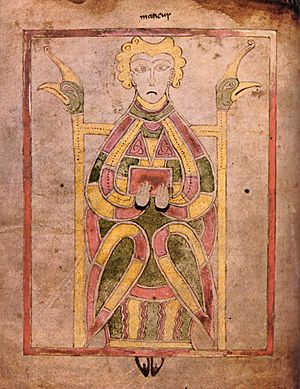Book of Dimma facts for kids
The Book of Dimma is a very old and special book from Ireland. It was made around the 8th century, which means it's over 1,200 years old! This book is a type of "pocket Gospel Book". A Gospel Book contains the stories and teachings of Jesus Christ from the Gospels of the New Testament. It was called a "pocket" book because it was small enough to be carried around easily.
This ancient book originally came from an abbey (a type of monastery) in Roscrea, County Tipperary, Ireland. This abbey was started by a saint named St. Crónán. The Book of Dimma contains the Gospels of Luke and John. It also has special prayers for people who are sick.
The book is famous for its beautiful decorations, called "illuminations." These include fancy first letters (called illuminated initials), pictures of the Evangelists (the writers of the Gospels), and symbols for each Evangelist. This style of art is part of what's known as Insular art, which was popular in Ireland and Britain a long time ago.
The Gospels in the book were written by different scribes (people who copied books by hand). One scribe, named Dimma MacNathi, signed his name at the end of each Gospel. For a long time, people thought this Dimma was a bishop mentioned in a letter from Pope John IV in 640. However, experts now believe it was a different Dimma.
The Legend of the Book of Dimma
A famous story tells us how the Book of Dimma was made. St. Crónán asked a monk named Dimma to copy the entire book. But there was a catch: Dimma had to finish it in just one day! This seemed like an impossible task.
Dimma started working without stopping, not even for meals. As he worked, something amazing happened: the sun never set! It stayed bright the whole time. When Dimma finally finished copying the book, he thought only one day had passed. But in reality, it had taken him forty days! This miracle was believed to be a special gift from St. Crónán.
The Book's Special Case: A Cumdach
In the 12th century, the Book of Dimma was given a very special and fancy case. This case is called a cumdach (pronounced "KOOM-dakh"). A cumdach is like a protective box or reliquary for important books or holy objects. It's often decorated with beautiful metalwork and jewels.
The cumdach for the Book of Dimma is still with the book today at Trinity College. One side of the case has detailed openwork designs. These designs are in a style called Ringerike, which was a popular Viking art style. There's a good copy of this cumdach made in 1908 at the Metropolitan Museum of Art in New York.
Who Owned the Book?
Over many years, the Book of Dimma was owned by different people. It belonged to William Meagher, a Catholic priest in Roscrea. Then it passed to his relative, Philip Meagher, who was a priest in Nenagh.
Philip Meagher lent the book to a Dr. Thomas Harrison. But Dr. Harrison did something wrong: he sold the book without permission to Henry Monck Mason. Mason was a librarian in Dublin. This happened sometime before 1816. The book was then shown to the Royal Irish Academy in 1819.
Later, a man named Sir William Betham bought the book before 1826. He tried to sell it himself in 1830. Finally, on March 29, 1836, he gave the manuscript to Trinity College in Dublin, where it is kept safe today.





